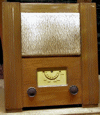Wartime Civilian Mains Set
This set was produced in 1944 by 42 different set makers

A simple set; built down to a specification and price. Original with two knobs and a mains on/off switch at the rear.
Individual manufacturers used whatever components were to hand so, although all sets are basically the same, there is little consistency in details. Control knobs are one instance of individuality.

Simple controls, Volume and Tuning. Medium waveband only.
A third knob was added to many sets after the war to switch to long wave.
When war broke out in 1939 all the British radio manufacturers switched to producing a wide range of military radio equipment for the armed forces. Perhaps the most famous product was the R1155 communications receiver used by the RAF. After a few years there was a shortage of radio repairmen as they had all been called up to maintain vital radio and radar equipment. Similarly there was a shortage of spare parts, particularly valves, as all production was for the services. This meant it was very difficult to get a radio repaired and with very few new sets available there was a desperate need to overcome the problem.
The Government solved this by arranging for over 40 radio manufacturers to produce sets to a standard design with as few components as possible consistent with ability to source them. Earlier the Government had introduced the 'Utility' brand to ensure that all clothing, which was rationed, was produced to a reasonable quality standard as prior to its introduction a lot of shoddy goods had appeared on the market. So the 'Utility' brand was adopted for this wartime radio. The Utility Set had limited reception on medium wave and lacked a longwave band to simplify the design. The tuning scale listed only BBC stations. After the war a version with LW was made available and modification kits to retrofit existing sets were marketed.
The sets used a four-valve superhet circuit with an audio output of 4 watts at 10% total harmonic distortion; they performed as well as many pre-war sets. The valve complement consisted of a triode-hexode frequency changer, a variable-µ RF pentode IF amplifier and a high slope output pentode. A "Westector" solid-state copper oxide diode was used for demodulation, which saved one valve and allowed use of an available type of pentode for the audio stage. The HT line was derived from a full wave rectifier. All valves were on International Octal sockets apart from the rectifier which was on a British 4-pin base. There were minor variations between set makers; for instance Philips used IF transformers with adjustable ferrite cores (so-called slug tuning) rather than the conventional trimmer capacitors.
The general public were unable to tell the manufacturer of a particular set although each manufacturer stamped a code letter on the radio to identify themselves to dealers. UK makers often used different designations for the same valve (tube). Octal tubes might be of USA origin. All valves in the Utility radio used standard designations prefixed by BVA (British Valve Association). They were produced by valve makers such as Mullard, MOV, Cossor, Mazda and Brimar. Dealers, knowing the maker of a set and which valve manufacturer that maker used, could easily deduce which pre-war types these were and make warranty claims on the manufacturer. About 175,000 sets were sold, at a price of £12 3s 4d each.
The set is often seen as the British equivalent of the German Peoples' Receiver (Volksempfänger), but the motivation was slightly different. The Volksempfänger was a range of sets designed to be cheap enough for all German citizens to afford. For those able to afford the expense, higher quality radios were always available, while the Utility Set was the only new radio receiver that could be purchased on the British market for much of the latter part of the war.